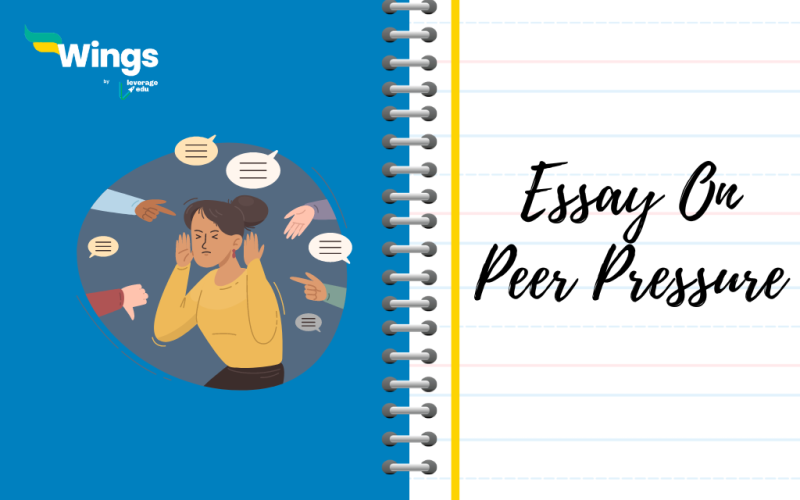Essay on peer pressure: Have you ever done something just because your friends or peers have done it? Say, watched a movie or TV series, visited places, consumed any substance, or academic achievement. This is a classic example of peer pressure. It means you are influenced by your peers or people around you.
Peer pressure can be both positive and negative, but mostly, it has negative effects. Peer pressure often occurs during adolescence or teenage years when individuals are more susceptible to the opinions and actions of their peers. Sometimes, peer pressure can lead to serious consequences. Therefore, we must deal with peer pressure in a civilized and positive way.
On this page, we will provide you with some samples of how to write an essay on peer pressure. Here are essay on peer pressure in 100, 200 and 450 words.
Table of Contents [show]
Master the art of essay writing with our blog on How to Write an Essay in English.
Essay on Peer Pressure in 450 Words
‘Be true to who you are and proud of who you’re becoming. I have never met a critic who was doing better than me.’ – Jeff Moore
Why do we seek recognition? Why do we want to fit in? Why are we not accepting ourselves in just the way we are? The answer to these questions is almost the same; peer pressure. Peer pressure is the influence of our peers in such a way, that we wish and try to do things in the same way as others did.
Negatives and Positive Peer Pressure
Peer pressure can have positive and negative effects. Positive peer pressure can result in better academic performance, personal growth and development, etc. We can be a source of inspiration to our friends or vice versa, which can result in better academic growth, adopting healthier lifestyles, and engaging in community service. For example, you are part of a group collaborating on a community project that demonstrates the constructive influence of peer interaction. This can encourage a sense of purpose and shared responsibility.
Negative Peer Pressure is the opposite of positive peer pressure. In such cases, we are influenced by the negative bad habits of our peers, which often result in disastrous consequences. Consider the scenario where one of your friends starts smoking simply to conform to the smoking habits of his peers, highlighting the potentially harmful consequences of succumbing to negative influences.
How to Deal With Peer Pressure?
Peer pressure can be dealt with in several ways. The first thing to do is to understand our own values and belief systems. Nobody wants to be controlled by others, and when we know what is important to us, it becomes easier to resist pressure that goes against our beliefs.
A person with self-esteem believes in his or her decisions. It creates a strong sense of self-worth and confidence. When you believe in yourself, you are more likely to make decisions based on your principles rather than succumbing to external influences.
Choosing your friends wisely can be another great way to avoid peer pressure. Positive peer influence can be a powerful tool against negative peer pressure.
Building the habit of saying ‘No’ and confidently facing pressure in uncomfortable situations can be a great way to resist peer pressure. So, it is important to assertively express your thoughts and feelings.
Peer pressure can have different effects on our well-being. It can contribute to personal growth and development, and it can also negatively affect our mental and physical health. We can deal with peer pressure with the necessary skills, open communication, and a supportive environment. We must act and do things in responsible ways.
Also Read: Essay on Green Revolution in 100, 200 and 500 Words
Essay on Peer Pressure in 300 Words
Peer pressure is a powerful influence that can shape a person’s choices, especially among students. It is the force exerted by friends or classmates to conform to certain behaviors, values, or attitudes. While it is often viewed negatively, peer pressure can have both positive and negative effects.
On the positive side, good peer influence can encourage students to develop healthy habits, work harder, and make responsible decisions. When surrounded by hardworking and disciplined peers, a student is more likely to adopt similar qualities. As the famous American author Charles Caleb Colton once said, “Imitation is the sincerest form of flattery.” This means that students often mirror the actions of those around them, making it important to choose the right company.
However, peer pressure is more commonly associated with its negative impact. Many students engage in risky behaviors, such as smoking, skipping school, or even cheating on exams, simply because they fear rejection or want to fit in. As Eleanor Roosevelt wisely said, “No one can make you feel inferior without your consent.” This highlights the importance of self-confidence in resisting harmful peer influence.
To handle peer pressure effectively, students should learn to assert themselves and make independent choices. Developing strong self-esteem, seeking guidance from parents or teachers, and surrounding oneself with positive influences can help resist negative pressure.
Ultimately, peer pressure is a part of life, but how we respond to it defines our character. By choosing good friends and standing firm in our beliefs, we can turn peer pressure into a force for growth rather than harm.
Essay on Peer Pressure in 200 Words
‘A friend recently started smoking just because every guy in his class smokes, and when they hang out, he feels the pressure to conform and be accepted within the group. However, he is not aware of the potential health risks and personal consequences associated with the habit.
This is one of the many negative examples of peer pressure. However, peer pressure can often take positive turns, resulting in better academic performance, and participation in social activities, and physical activities.
Dealing with peer pressure requires a delicate balance and determination. Teenagers must have alternative positive options to resist negative influences. Developing a strong sense of self, understanding personal values, and building confidence are crucial components in navigating the challenges posed by peer pressure.
Learning to say ‘No’ assertively can be a great way to tackle peer pressure. You must understand your boundaries and be confident in your decisions. This way, you can resist pressure that contradicts your values. Also, having a plan in advance for potential pressure situations and seeking support from trusted friends or mentors can contribute to making informed and responsible choices.
‘It is our choice how we want to deal with peer pressure. We can make good and bad decisions, but in the end, we have to accept the fact that we were influenced by our peers and we were trying to fit in.’
Essay on Peer Pressure in 100 Words
‘Peer pressure refers to the influence of your peers. Peer pressure either be of positive or negative types. Positive peer pressure can encourage healthy habits like academic challenges, physical activities, or engaging in positive social activities. Negative peer pressure, on the other hand, can lead us to engage in risky behaviours, such as substance abuse, reckless driving, or skipping school, to fit in with our peers.’
‘There are many ways in which we can deal with peer pressure. Everyone has their personal beliefs and values. Therefore, they must believe in themselves and should not let other things distract them. When we are confident in ourselves, it becomes easier to stand up for what we believe in and make our own choices. Peer pressure can be dealt with by staying positive about yourself.’
Essay on Peer Pressure for Class 10
Peer pressure is an inevitable part of growing up. It refers to the influence exerted by friends, classmates, or social groups on an individual, often pushing them to conform to certain behaviours, values, or actions. While peer pressure is mostly seen in a negative light, it can also have a positive impact. Whether it leads to good or bad decisions depends on how an individual responds to it.
Types of Peer Pressure
Peer pressure can be both positive and negative.
- Positive Peer Pressure: When friends encourage you to study harder, adopt good habits, participate in extracurricular activities, or stay away from harmful substances, it is positive peer pressure. Being surrounded by motivated and disciplined individuals can inspire students to improve themselves. As the famous saying goes, “A man is known by the company he keeps.”
- Negative Peer Pressure: This occurs when peers push someone to engage in harmful or undesirable activities, such as smoking, drinking, skipping classes, or bullying. The desire to fit in often forces students to act against their values. As Eleanor Roosevelt wisely said, “No one can make you feel inferior without your consent.” This means that resisting peer pressure requires self-confidence and strong willpower.
Causes of Peer Pressure
Several factors contribute to peer pressure among students:
- Fear of Rejection: The need to feel accepted can push students to conform, even if it goes against their morals.
- Desire to Fit In: Adolescents often believe that being part of a group makes them more socially acceptable.
- Low Self-Esteem: Those who lack confidence are more vulnerable to negative influences.
- Media and Trends: Social media plays a significant role in shaping behaviours, often making certain habits or actions seem “cool” or desirable.
Effects of Peer Pressure
The impact of peer pressure can be both constructive and destructive.
Positive Effects:
- Encourages academic excellence by motivating students to perform better.
- Promotes healthy competition in studies and sports.
- Inspires students to engage in social work, environmental conservation, or fitness activities.
Negative Effects:
- This leads to harmful habits like smoking, drug abuse, or skipping school.
- Creates stress, anxiety, and mental health issues due to the pressure of fitting in.
- Causes a loss of individuality, as students may start making choices based on others’ opinions rather than their own beliefs.
How to Overcome Negative Peer Pressure?
1. Build Self-Confidence
Having faith in oneself is the best defense against negative influences. As William Shakespeare wrote, “This above all: to thine own self be true.” If you believe in your values, it becomes easier to say no to bad influences.
2. Learn to Say ‘No’ Firmly
It is essential to develop the courage to refuse harmful suggestions. Saying “No, I’m not comfortable with this” or simply walking away from a negative situation can make a huge difference.
3. Choose Friends Wisely
As the proverb goes, “Tell me who your friends are, and I will tell you who you are.” Surrounding oneself with positive, supportive, and ambitious friends can encourage personal growth and success.
4. Seek Guidance from Trusted Adults
Talking to parents, teachers, or counselors can help in dealing with peer pressure. Adults have more experience and can offer practical solutions.
5. Focus on Personal Goals
When students stay committed to their dreams and ambitions, they are less likely to be swayed by peer pressure. Having a clear vision of one’s future can help in making the right choices.
Peer pressure is a double-edged sword—it can either build a person up or bring them down. It is up to the individual to decide how to handle it. By developing self-confidence, choosing the right company, and standing firm in one’s beliefs, students can turn peer pressure into a force for good. As the famous saying goes, “Stand for what is right, even if you stand alone.”
Ultimately, peer pressure should never overpower one’s values. Instead, it should be an opportunity to grow, learn, and make better choices. After all, the best way to shine is to stay true to oneself!
FAQs
Ans: ‘Peer pressure refers to the influence of your peers. Peer pressure either be of positive or negative types. Positive peer pressure can encourage healthy habits like academic challenges,, physical activities, or engaging in positive social activities. Negative peer pressure, on the other hand, can lead us to engage in risky behaviours, such as substance abuse, reckless driving, or skipping school, to fit in with our peers.’
Ans: Peer pressure refers to the influence of our peers or people around us.
Ans: Peer pressure can have both positive and negative effects on school children. It can boost academic performance, encourage participation in social activities, adopt healthier lifestyles, etc. However, peer pressure often results in risky behaviours, such as substance abuse, unsafe activities, or other harmful behaviours.
Related Articles
For more information on such interesting speech topics for your school, visit our speech writing page and follow Leverage Edu.
 One app for all your study abroad needs
One app for all your study abroad needs















 45,000+ students trusted us with their dreams. Take the first step today!
45,000+ students trusted us with their dreams. Take the first step today!
